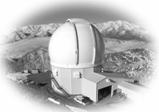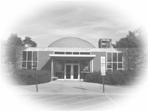
 After Dark
After Dark
The Monthly Newsletter of the Michigan State University Astronomy Program: September 2004: No.10
WE’RE BACK!
With this edition, we resume our monthly astronomy newsletter for the 2004-2005 academic year. Our goal is to keep Lansing-area residents who are interested in astronomy up-to-date on the many astronomical events at MSU. We will tell you about the public outreach program that we offer through the Abrams Planetarium and through the efforts of our research scientists. We also will keep you informed about the latest scientific discoveries from our strong astrophysics research program, which is carried out by the astronomy group within the Physics & Astronomy Department, the nuclear physicists at the National Superconducting Cyclotron Laboratory, and now also within our high energy physics group. MSU is a partner in the new 4m-diameter SOAR Telescope in
THE CENTER FOR THE STUDY OF COSMIC EVOLUTION
This new on-campus Center includes research scientists from the astronomy, nuclear physics and high-energy physics groups. Our goal is to study the evolutionary processes that have changed our universe from a nearly featureless sea of very hot elementary particles shortly after the Big Bang 13.7 billion years ago, into the complexly structured cosmos of giant galaxy clusters, galaxies, stars and planets that we see around us today. It is thought that this occurred through processes in which the major components of the universe are the recently-discovered “dark energy”, which effectively pushes everything apart, and the long-known but poorly-understood “dark matter”, which pulls all matter together through the force of gravity. The normal matter, including protons, neutrons and electrons, and hence the atoms that make up the earth and ourselves and which is the matter that we can actually see through its interaction with light, is a minor constituent of the universe, and has been pulled by the dark matter into the gravitational condensations that were the building blocks of today’s large galaxies. The normal matter then formed individual stars and evolved chemically through nuclear reactions within those stars to build up the complicated atomic nuclei of the heavier chemical elements including those of which we are made. The Cosmic Evolution center will work to trace the detailed history of these processes over the time span since the earliest observable proto-galaxies were formed. Its major experimental tool will be the SOAR Telescope.
RESEARCH HIGHLIGHT
Professor Ed Brown is the newest member of the astronomy group, and is also affiliated with the Joint Institute for Nuclear Astrophysics. He is a theorist whose interests include compact objects (white dwarfs and neutron stars) and astrophysical nuclear processes. He is currently working on modeling the intricate chains of nuclear reactions that occur when a white dwarf star explodes (called a type Ia supernova) and on how explosions on the surfaces of neutron stars provide information about matter at nuclear densities. Studying these astrophysical explosions combines insight from blackboard mathematics with computations on some of the world’s most powerful computers. Ed will describe some of this work in the first talk of this year’s Astronomical Horizon lecture series (see reverse side).
ACTIVITIES FOR SEPTEMBER
1. MSU Observatory Open Houses: Friday & Saturday, Sept. 24 & 25, 9:00-11:00 PM. View the sky through the MSU 24-inch telescope (Weather permitting. Don’t come if it’s cloudy). Free Admission. See www.pa.msu.edu/astro/observ for a map.
2. Abrams Planetarium:Shows resume Friday Sept. 24 after sound system renovations are completed. Feature show: “RING WORLD”, Fridays & Saturdays 8PM, Sundays 4PM. Family show: “THE SUPER SKY SHOW” Sundays 2:30PM ($3.00 adults, $2.50 students & seniors, $2.00 children under 12)
3. Abrams Planetarium Lecture: 7:30 PM Thursday September 16 (See reverse side).
Visit the Department of Physics & Astronomy and Abrams Planetarium web sites at www.pa.msu.edu and www.pa.msu.edu/abrams/ respectively for more information.